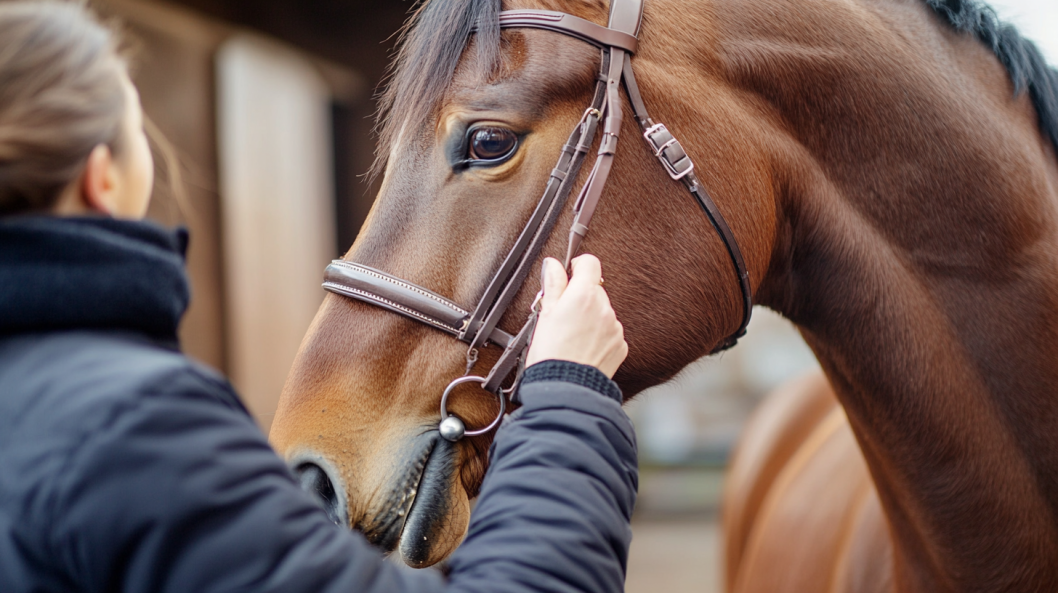Proper bridle fitting is crucial not just for the immediate comfort of your horse but also for optimizing its performance and preventing potential health issues. A poorly fitted bridle can create pressure points that lead to pain and irritation, resulting in behavioral problems such as head tossing or reluctance to work. This discomfort can distract your horse and undermine its performance, making it difficult for both horse and rider to achieve their best.
I firmly believe that the bridle is one of the most crucial equipment for a horse, far beyond its role in aesthetics or control. A well-fitted bridle is fundamental to the horse’s comfort and overall well-being because it directly impacts how it experiences and responds to training and riding. Unlike other tack, the bridle interacts intimately with sensitive areas of the horse’s head, including the mouth, nose, and forehead. Here’s a guide to some common bridle-fitting mistakes and tips on how to avoid them:
1. Incorrect Bit Placement
Mistake: One of the most common mistakes is placing the bit too high or too low in the horse’s mouth. Too high can cause pressure on the palate, while too low may press on the tongue or interfere with the horse’s teeth.
Solution: The bit should sit comfortably in the horse’s mouth, with the bars resting in the spaces between the teeth, and the bit should be level when the horse’s mouth is closed. Check for about one to two wrinkles at the corner of the mouth when the bit is in place.
2. Poor Noseband Fit
Mistake: A noseband that is too tight can cause discomfort and restrict the horse’s ability to breathe, while one that is too loose may not effectively control the horse’s head.
Solution: The noseband should be snug enough to prevent excessive movement but not so tight that it causes discomfort. You should be able to fit two fingers between the noseband and the horse’s nose.
3. Incorrect Browband Size
Mistake: A browband that is too tight can cause pinching and discomfort, while one that is too loose can cause the bridle to slip forward.
Solution: The browband should fit comfortably across the horse’s forehead without pinching. It should sit snugly but with enough room to allow some movement and should not interfere with the horse’s eyes or ears.
4. Mismatched Bridle Parts
Mistake: Using parts from different bridles or mismatched sizes can lead to poor fit and function. For example, using a full-size bit with a cob-sized bridle can create issues.
Solution: Ensure that all parts of the bridle, including the cheekpieces, noseband, and throatlash, are the correct size and compatible with each other. When in doubt, consult with a knowledgeable fitter or professional.
5. Neglecting Regular Adjustments
Mistake: Horses can change shape and size due to weight changes, muscle development, or seasonal variations, so a bridle that once fits well may become uncomfortable over time.
Solution: Regularly check and adjust the bridle to accommodate changes in the horse’s shape or size. A good practice is to inspect the fit before and after every ride and make necessary adjustments.
6. Ignoring the Horse’s Feedback
Mistake: Not paying attention to signs of discomfort, such as head tossing, rubbing, or reluctance to work, can lead to worsening issues.
Solution: Always observe your horse’s behavior and reactions. If you notice signs of discomfort or resistance, re-evaluate the bridle’s fit and adjust as needed.
7. Using Worn or Damaged Equipment
Mistake: Using bridles that are worn out or damaged can compromise fit and comfort, potentially causing harm to your horse.
Solution: Regularly inspect your bridle for signs of wear or damage. Replace any worn or damaged parts promptly to ensure the bridle remains in good condition.
In my opinion, ensuring a proper bridle fit is not merely a matter of routine; it’s a commitment to the horse’s comfort and overall performance. Every adjustment, every inspection, and every piece of equipment plays a role in how your horse feels and performs. By taking a proactive approach to bridle fitting and avoiding common mistakes, you enhance your horse’s well-being and strengthen the bond between you and your equine partner.





